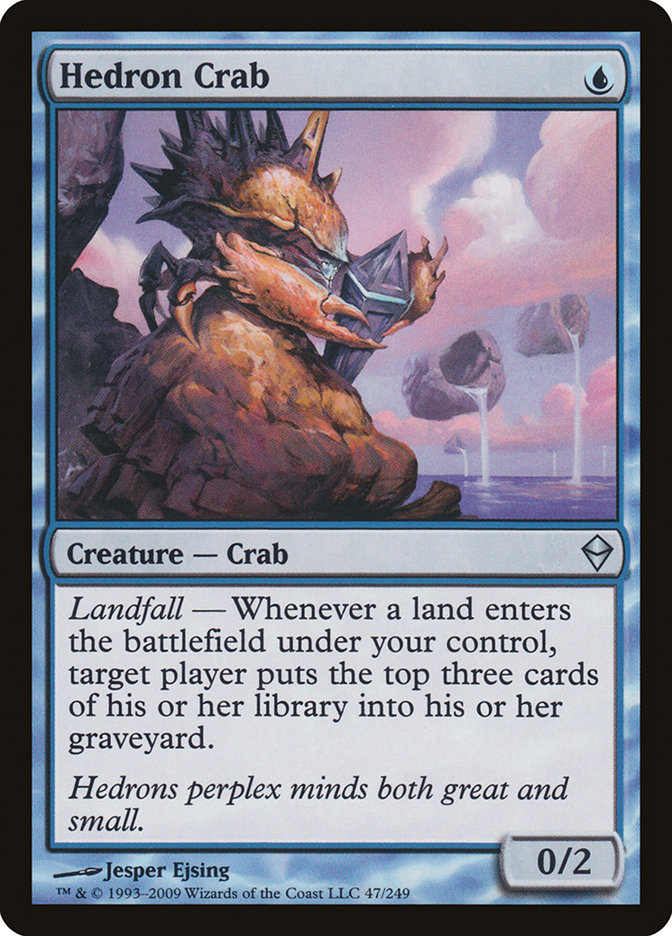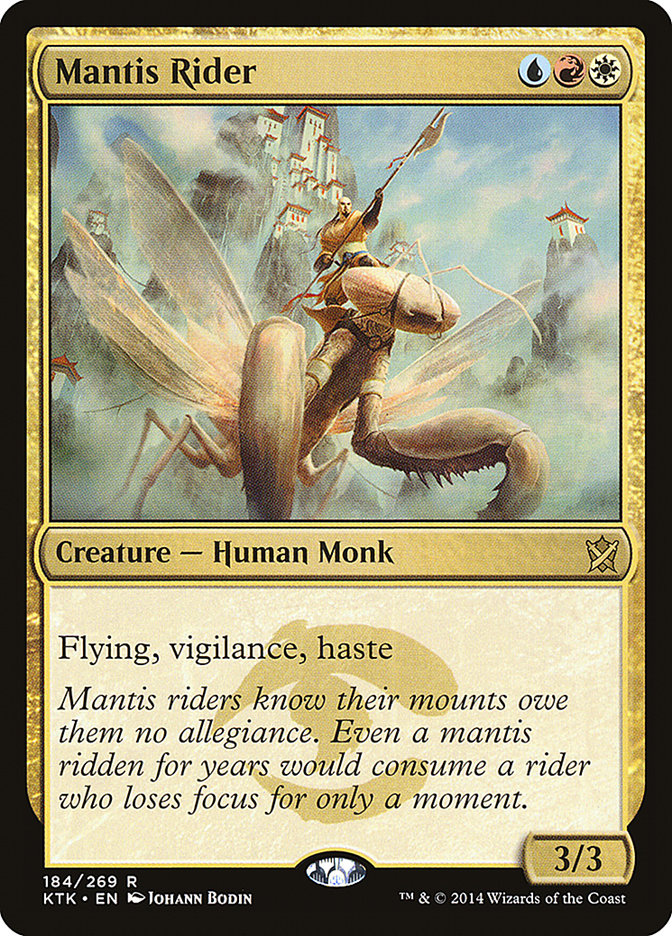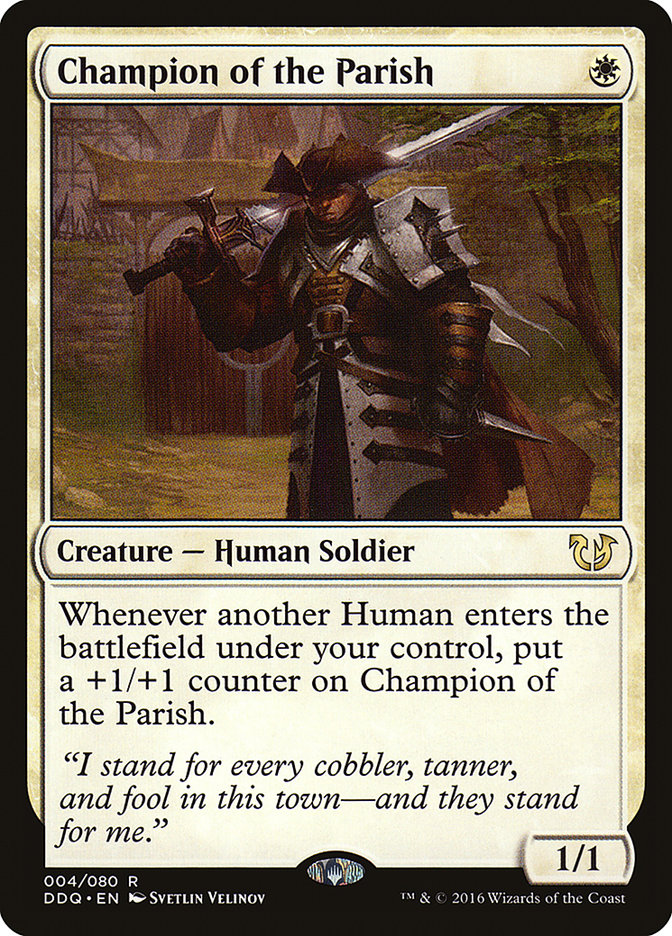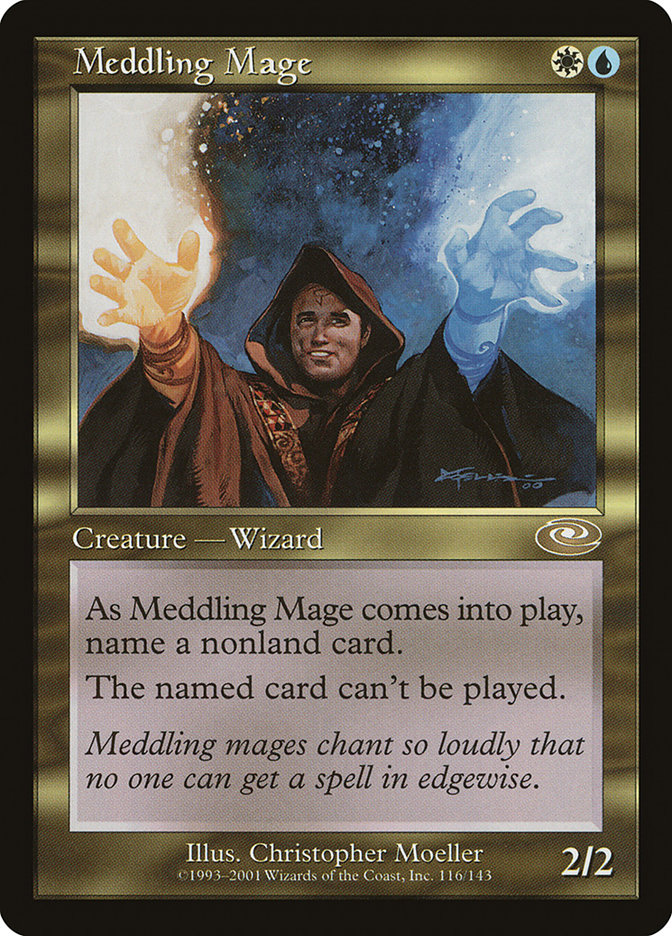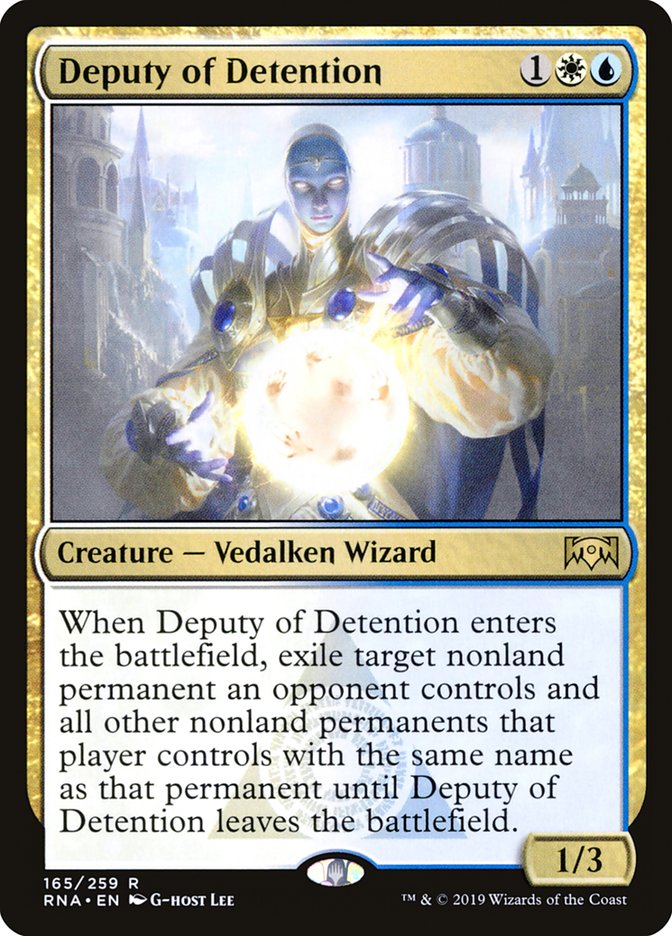Mythic Championship IV is in the books and I’m proud to say it was tied for my best Mythic Championship of the year. Unfortunately, a 9-7 finish isn’t exactly something to write home about. Still, I was happy with my late switch from the talk of the tournament, Hogaak, to my trusty Humans.
While Hogaak has a multitude of strengths, and the 56% win rate it posted at the Mythic Championship helps reinforce this, the deck also has some weaknesses that Humans is able to exploit nicely. Today I’ll pinpoint what gives this tribe strength against the current Modern menace and how to approach the matchups common in today’s metagame.
To begin, here’s the list I played in Barcelona:
Creatures (37)
- 4 Meddling Mage
- 4 Noble Hierarch
- 4 Phantasmal Image
- 4 Champion of the Parish
- 4 Thalia, Guardian of Thraben
- 4 Mantis Rider
- 4 Reflector Mage
- 4 Thalia's Lieutenant
- 3 Kitesail Freebooter
- 2 Deputy of Detention
Lands (19)
Spells (4)

A significant part of my motivation to play Humans is because of how well your general strategy plays against the structural problems of Hogaak. The primary angle that you want to attack is the life total. It isn’t exactly a groundbreaking thing to say when explaining how to pilot an aggro deck, but it is of critical importance in today’s Modern.
When looking at why the newest boogeyman is weak in that way, you have to begin by looking at the manabase of Hogaak. It operates off almost an entirely fetchland / shockland manabase while also needing to cast both red and green spells early. You can see how this puts Hogaak in a precarious situation. You can either fetch to unlock all your spells and spot your opponent around six points of life, or eschew a color and leave yourself vulnerable to drawing uncastable spells. This weakness is exacerbated in versions featuring Hedron Crab, as the blue one-drop fails to play good defense while also plummeting your life total even lower to cast it in a relevant timeframe.
The lack of flexibility that Hedron Crab presents is actually a common thread amongst the creatures of Hogaak and another point of vulnerability. Gravecrawler, Carrion Feeder, and Bloodghast are all powerful cards that are key to enabling graveyard synergy, but the power rolled into these cards comes at a cost. Having such a significant portion of your creatures unable to block forces you into trying to race, and should you find yourself falling behind, this entire suite of cards can be rendered irrelevant. These costs are mitigated by how dominant Hogaak can be once it gets onto the battlefield. Aggro decks that depend upon damage-based removal flounder here; while Lightning Bolt has been a premier removal spell for much of Modern’s history, it’s actually just laughable against the recursive or gigantic threats of Hogaak.
So generally speaking, to win against Hogaak, you’ll need the combination of aggression that can take advantage of a virtual starting life total of twelve to fourteen and the ability to shrug off the potential of an 8/8 ground blocker. Since this is an article about Humans, I’m happy to say this is where they enter into the equation. Mantis Rider is the perfect threat here, hitting early and providing evasion to ensure continued damage, and what Champion of the Parish lacks in flying, it makes up in sheer potential power.
Another mainstay of Humans that has seen large gains in value recently is Meddling Mage.
With most stock Hogaak lists skimping on interaction, frequently playing only three copies of Lightning Axe, Meddling Mage can be hugely relevant in several different ways. The first and most typical way to stymie your opponent is to name their only piece of interaction and lock them out of being able to disrupt your creatures at all.
While this is an occasionally useful and certainly powerful avenue to have access to, I’ve found more success frequently naming creatures. On the play you can name Hogaak and gut the deck of the most potent threat in the matchup, leaving only Vengevine as a card to beat. Another common name is Gravecrawler, as doing so allows you to stop Carrion Feeder depositing it into the graveyard to enable recasting it several times in the same turn, triggering Vengevines or simply growing an out-of-control threat.
The final regular amongst the maindeck of Humans that I’d like to highlight is Reflector Mage. Being able to bounce the 8/8 gives you the perfect interaction for the job, and when you keep the namesake card under control, beating the motley crew of smaller creatures is a manageable task, especially considering how well a 2/3 body holds the ground against Bloodghast and Gravecrawler.
While most of the maindeck is stock, I am a huge proponent of playing Deputy of Detention over Militia Bugler in the precious flex spots. The primary reason is just how absolutely necessary it is to remove Hogaak and having redundancy to the Reflector Mage effect is welcome. Another boon for the Deputy comes from the flexibility, as Modern has long been a format to present a diverse set of threats to be answered. Naturally, then, having at least some play against the wide variety of nonsense that can be thrown at you (Ensnaring Bridge, Wrenn and Six, and Blood Moon, to name a few) carries value.
The sideboard is full of the usual suspects surrounding the incredibly hateful Leyline of the Void. Despite Leyline being surprisingly easy to answer, I desperately want my hate to be a knockout and Hogaak has very little to do if you can begin the game with Leyline on the battlefield. I’ve considered alternatives that have less power but more utility if drawn later, like Grafdigger’s Cage or Ravenous Trap. I think the issue here is that you still need your hate spells early to not get run over by a Turn 2 Hogaak, so if the timing window is so forcibly narrow, I’m willing to exchange some potentially abysmal topdecks to get myself free wins. I’m not sure if anyone plays traditional Dredge anymore, but since the introduction of Blast Zone the matchup’s changed significantly for the worse, so I’ll take the help there.
While Hogaak is a popular and dominant deck, it isn’t the only thing that you’ll play against and it’s important to know how to tweak, tune, and play your list if you want game against the other most-played decks in the format. I’d like to take a bit to talk in broad strokes regarding how Humans lines up against the rest of the well represented metagame from Mythic Championship IV and how you should approach each matchup.
Creatures (10)
Lands (18)
Spells (32)

A matchup that is generally close, but historically I’ve been happy to be on the side of Humans and I believe that holds true today. Using Reflector Mage and Deputy of Detention to keep Thing in the Ice under control is paramount, and naturally Thalia, Guardian of Thraben is still unbelievable. The percentage points can swing with just a few flex spots either way, but Izzet Phoenix playing Surgical Extraction over Gut Shot really helps.
Creatures (17)
Planeswalkers (4)
Lands (24)
Spells (15)

The shift from traditional Mono-Green Tron to the Eldrazi variant was another large upgrade in metagame positioning for Humans. Eldrazi Tron packs fewer sweepers and smaller creatures, and the Chalice of the Void plan falls flat against both Cavern of Souls and Aether Vial. All in all, pretty good and a matchup I hope to continue to get to play. In-game, the biggest threats to be aware of are All Is Dust and Walking Ballista to clear the battlefield, but if you can keep these under control, you’re likely to be favored.
Creatures (37)
- 4 Meddling Mage
- 4 Noble Hierarch
- 4 Phantasmal Image
- 4 Champion of the Parish
- 3 Thalia, Guardian of Thraben
- 4 Mantis Rider
- 4 Reflector Mage
- 4 Thalia's Lieutenant
- 1 Militia Bugler
- 2 Deputy of Detention
- 3 Unsettled Mariner
Lands (19)
Spells (4)

Like most mirrors, this one feels like a bit of a crapshoot. Stacking large ground creatures like Champion of the Parish and Thalia’s Lieutenant and killing with Mantis Rider are the most reasonable paths to victory, and if you know you’re playing the matchup, I’d aggressively mulligan hands that are too full of cards like Kitesail Freebooter; Thalia, Guardian of Thraben; or Meddling Mage. This is the only prevalent matchup I know I desperately want Plague Engineer against, so if you’re willing to sacrifice a bit, that’s how I would generate extra sideboard space.
Creatures (14)
Planeswalkers (7)
Lands (23)
Spells (16)

It is difficult to call your matchup against Jund anything other than heinous. In fact, I thought it has long been nightmarish even before Modern Horizons introduced Wrenn and Six and Plague Engineer in the sideboard. I think the best way to improve your chances is to increase the number of Militia Bugler to enable your general grinding potential while increasing potency of otherwise strandable cards like Phantasmal Image or Thalia’s Lieutenant. Dismember is another card I found myself potentially wanting more of, as killing those Engineers is just that important. Overall, this is a huge red flag. Should Jund rise in popularity even more, consider that Humans likely won’t be the best choice.
Creatures (4)
Planeswalkers (8)
Lands (24)
Spells (24)

Few existing decks have gotten as much of a facelift with the release of War of the Spark and Modern Horizons as Azorius Control. Narset, Parter of Veils; Teferi, Time Raveler; and Force of Negation have drastically increased the overall power of the premier control strategy in the format, but these cards have appeared to be poorly positioned in the matchup. With Force incentivizing more blue spells, Meddling Mage should prioritize Path to Exile then Supreme Verdict, as Wrath of God now actively has an opportunity cost to include in their deck.
A subtle aspect of what makes the games so winnable is the second basic land to reduce the efficacy of Path to Exile and Field of Ruin, and it’s possible you can cut your basic Island and still be a favorite here. Gaddock Teeg remains your best sideboard option and I would be willing to play a second copy despite how difficult the mana cost can prove to be.
While playing a deck that isn’t Hogaak in the current Modern format feels like swimming upstream, Humans is a deck with a ton of merit and play against the wide variety of decks you may face. Combine this with a positive matchup against the best deck and I think you have a package that will continue to perform amongst the best decks in the format moving forward.


